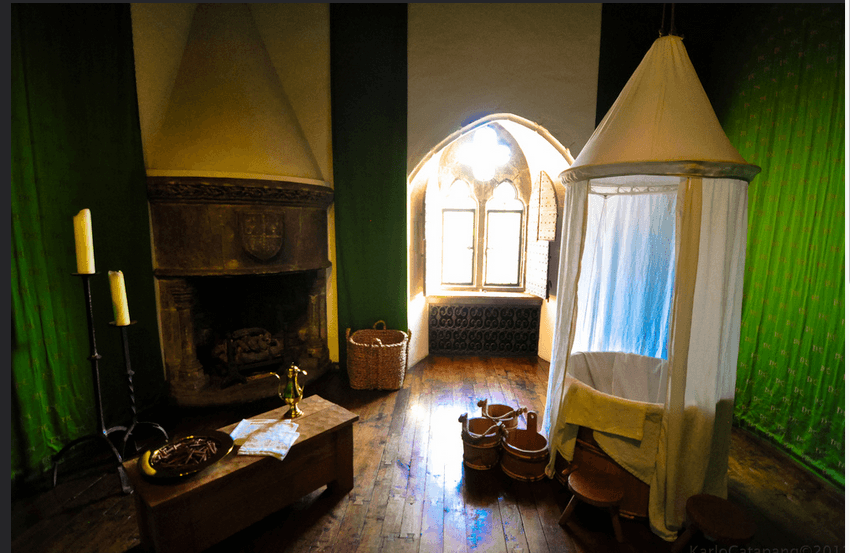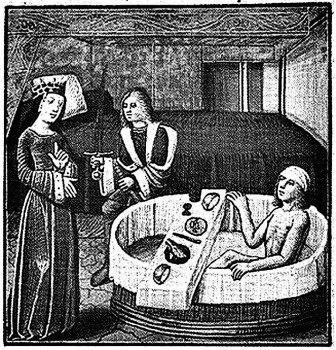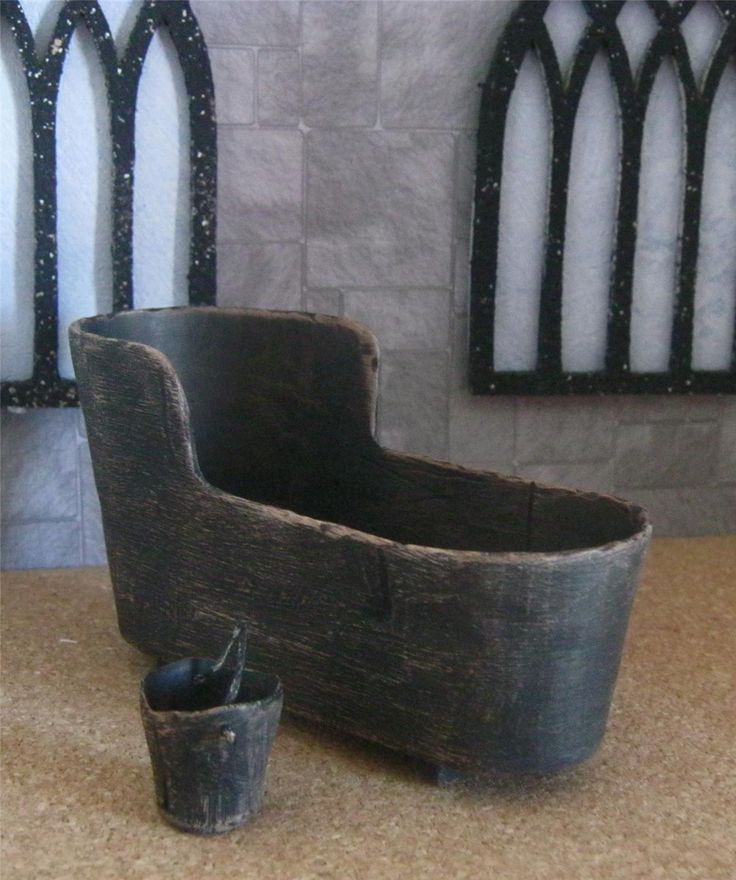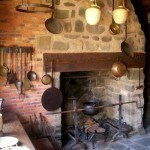
The Queen’s Bath at Leeds Castle in Kent. Henry VIII made this castle his principal home when he married Katherine of Aragon – wife #1.
Tudor Bathing Habits
The Tudors gave us the first room devoted to bathing, even the first indoor plumbing since the Romans. The Tudor version included hot water. But that comes at the end of the Tudor era and was affordable only by the very rich.
For the dollhouse enthusiast, it’s the little things that count. Soap from Castile, handheld mirrors, little imported jars to store cosmetics. This is all for the Royals and the gentry, of course. Bathing for most of the population consisted of dipping rags into wooden or earthen bowls three of four times a year. Soap made of animal fat – optional.
In The Manor House
Taking a bath involved servants fetching water, heating it, carrying it to the bed chamber where it would be poured into a tub – a wooden tub often lined with cloth to avoid splinters in awkward places.‘Exotic, imported fragrances and oils’ would be added; bathing soap — also imported — made from olive oil and perfumes was preferred.
Like most of the population, this only happened two or three times a year because it was believed that if one bathed more often, the natural healing properties of the body would be washed away. For rest of the year they would take a “sponge” bath and rub their bodies with fragrances and oils to cover the odors.
During the latter part of the Tudor era, rooms used specifically for bathing began to appear. Some could be quite elaborate, with ornate pieces of furniture and a hanging tapestry. The wealthy could add a pumped in water supply. It was crude compared to our standards, but effective and surprisingly similar.
A small room backed onto the bathroom wall, with a stove or boiler built against it. Two tanks of water were filled by servants. One would be heated by the boiler and the other would be left cold. These tanks would each have a pipe with a crude tap going through the wall to the bathing tub. The occupant could then bask for as long as they wished, topping up the hot water as required.
The bathroom was usually placed on the ground floor and in a convenient location close to a supply of water. The early systems did not have a drain. Disposing of dirty water was a task for another unlucky servant.
Beautifying Oneself
Lotions and perfumes were kept in china pots or glass phials which were stored in beautiful wooden boxes. The dressing room, decorated with silk hangings, became a reception room where the toilette was carried out in public. Vanity was no longer a sin, but a virtue.
The wealthy had mirrors, usually with beautifully carved frames in silver, ivory or wood. The Venetians were the first to make ‘looking glasses’ by backing glass with silvery tin or mercury. They managed to keep this process secret until it was smuggled to Paris by craftsmen working for the king of France. From Paris, the method spread throughout Europe, eventually reaching Britain around 1470. By the time the Tudors gained power, hand-held and moderately sized-wall were available – for a price.
Dental Care
The tooth brush would not be developed for another 150 years, but various herbal mixtures were available to be rubbed on the teeth with a clean cloth. Bay leaves soaked in orange flower water and mixed with musk; a mint and vinegar mixture made a good mouth wash; mint, cloves, cinnamon, or sage were used to freshen the breathe. All would have been kept in small jars with lids or decorated wooden boxes.
There were many recipes for tooth powder. I have chosen to included the grossest, which comes of having sons and grandsons. Mouse Head Tooth Powder: First you catch some mice. Cut off their heads. Cook them in a pan until they are burned. Pound them to a gritty powder. Then use the powder to clean your teeth. Yuck!
Merchant Class Bathing
The merchant class grew rapidly during the Tudor era. As most were social climbers, it is difficult to say how their bathing habits differed from gentry. The best rule of thumb for your miniature project would be to remember that most members of their class, or their wives, wanted what the gentry had. Be consistent with furnishings and accessories. If the owner of the house was struggling financially, but wanted to put on a good show for the neighbors, scarce resources would be spent on the public rooms: great hall (living room), parlor, dining room. As their assets increased, other rooms in the house would be decorated and added to the visitor’s tour.
The Humble Did Bathe
Most peasants were still in the bowl and wash cloth stage of bathing. If they had a wash tub, the water was reused. The man of the house had first dibs, then the mother and down the line ranked by age. By the time it was the youngest’s turn, the water would be so dirty it was opaque. Hence the expression, “Don’t throw the baby out with the bathwater.” Feel around under the surface before giving the tub the old heave-ho.
For the miniature enthusiast, there is little to purchase for the bathing facilities in the dollhouse of a struggling Tudor merchant or peasant. You might have to make your own furnishings and accessories, which is not all bad. There are many how-to video and PDF tutorials online to guide you.
Susan Downing, with Patrick Owens







